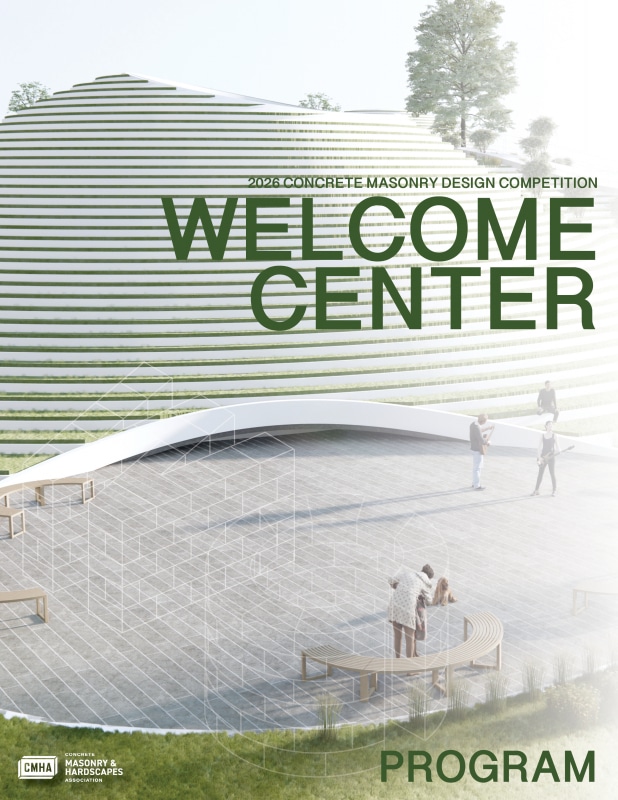Registration Deadline: April 3, 2026
2026 Concrete Masonry Competition
Welcome Center
Program
Reimagining the Welcome Center of Tomorrow
Overall programming of the welcome center is up to the student and/or faculty sponsor. It should include a variety indicated below and allow space for different types of public uses. Consider universal design and the different types of individuals who would use the welcome center. Students should also consider sustainability and reducing environmental impacts in their design.
The following is a list of programmatic spaces that needs be included in the welcome center. Solutions should observe the given spaces and sizes within a range of plus or minus ten percent.
Building Public Spaces
Lobby / Reception | 300 sq. ft. |
Exhibit / Information Area | 500 sq. ft. |
ADA Public Restrooms | 1,000 sq. ft. |
Rest and Relaxation Zone | 1,000 sq. ft. |
Children Play Area | 500 sq. ft. |
Café or Restaurant Outlet | 1,000 sq. ft. |
Dining Area | 2,000 sq. ft. |
Building Support Spaces
Emergency Aid Facility | 200 sq. ft. |
Offices | 300 sq. ft. |
Storage | 200 sq. ft. |
Mechanical (HVAC, electrical) | 150 sq. ft. |
Janitor Closet | 100 sq. ft. |
Staff Restrooms | 100 sq. ft. |
Building Totals
Building Net Area | 7,350 sq. ft. |
Circulation & Services (20%) | 1,470 sq. ft. |
BUILDING GROSS AREA | 8,820 sq. ft. |
Outdoor Spaces
Playground | |
Pet Relief Area | |
Parking with EV Charging |
Site
The site for the competition is the choice of the student and/or faculty sponsor. Submissions will be required to explain the site selection, strategy, and access graphically or otherwise.
CONSTRUCTION TYPE
The primary structural system must be concrete masonry. This can be architectural block, single-wythe concrete masonry or multi-wythe, with the backup being CMU. Participants are encouraged to consider innovative ways to use concrete masonry products in interior, exterior, and landscape applications. Outdoor spaces can include concrete masonry (such as screen or privacy walls) as well as other dry-cast concrete products, such as concrete pavers and segmental retaining wall units.
Concrete Masonry Units (CMU)
CMU are manufactured using dry-cast concrete on high-speed manufacturing equipment. Dry-cast concrete differs from other types of concrete in that it is initially mixed to a very stiff consistency. This consistency facilitates production through manufacturing equipment. This equipment utilizes compaction and vibration to form the units, and a curing process to accelerate hardening.
There are several American Society for Testing and Materials (ASTM) specifications that cover concrete masonry products. The primary one is ASTM C90, Standard Specification for Loadbearing Concrete Masonry Units.
Additional Concrete Products
The manufacturing process for CMU is also used to make a variety of other types of products, including segmental retaining wall (SRW) and concrete paving units. These are primarily used in hardscape applications (residentially, commercially, and more).
Competition Organizers & Sponsors
Questions
Edwin Hernández-Ventura
Programs Coordinator
ehernandez@acsa-arch.org
202.785.2324
Eric W. Ellis
Senior Director of Operations and Programs
eellis@acsa-arch.org
202-785-2324

 Study Architecture
Study Architecture  ProPEL
ProPEL 



